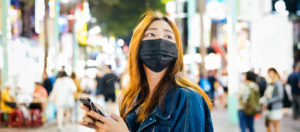In the beginning of 2000s, the million-dollar question in multicultural marketing has been “In-language or English?” Some brands may still be asking that question, but many have shifted the perspective to acculturation. Many factors can influence an individual’s acculturation level – time spent in America, age of immigration, language preference, education level, and the list goes on. Although the acculturation model can be complex, the patterns are fairly intuitive. Among the foreign-born Asian Americans, the unacculturated segment has been known to trend older, married with kids, and prefer their native languages than English. The more acculturated segment is usually known to be young, single, and more likely to consume content and converse in English.
But this is no longer the case. The immigration landscape in U.S. has been drastically changing in the last 5 years.
2017 Census Bureau data confirmed a major shift – new immigrants from Asia have surpassed those from Latin American as the largest contributor. Asian immigrants increased by 2.6 million since 2010, more than double the 1.2 million new immigrants from Latin America. In 2016, 37% of new immigrants were Asian vs. 31% were Latin American. In 2016, the top country of origin for new immigrants was India (126,000), followed by Mexico (124,000), China (121,000) and Cuba (41,000). According to Pew Research Center projections, Asians will make up 38% of all immigrants by 2065, followed by Hispanics (31%,) whites (20%), and blacks (9%.)
A major driving force behind the increase was the huge rise of international students from Asia. According to the Global Youth Trend report from Institute of International Education, 78% of international students pursuing U.S. diplomas were from Asia. Among them, China was the biggest source of contribution. The total number of students from China increased by 48% between 2013 and 2016, compared to 12% increase in overall international students in the U.S. Today, 3 In 5 international students enrolled in American high schools and colleges came from China.
This change is impacting more than DMAs already with high Asian density. Because of the location of prestigious schools, the rise of international students are creating bigger impact in suburban areas with historically low Asian American population. For example, the University of Illinois at Urbana-Champaign (UIUC) has seen a sizable increase in the number of Chinese students, from 37 enrolled in the undergraduate college in 2000 to 2,898 in 2014. Their significant economic contribution on campus and in the local economy has given Chinese international students the clout to effect change. The outskirt town of Mesa, AZ has also seen a large increase of Asian immigrants due to its proximity from Arizona State University in Phoenix. According to the Arizona Asian Chamber of Commerce, Asians own more than 22,000 businesses in and employ 42,000-plus residents. They generate $6.1 billion in revenue despite making up 4 percent of the population, with many entrepreneurs taking on and turning around undesirable properties.
This change has also created significant and complex influences to the overall Asian American community, especially among millennials and Gen-Z. Most of these international students came from middle-class or wealthier families back in Asia. They have extremely strong sense of pride in their roots. Unlike many U.S. born Asian Americans their age, these international students didn’t grow up with the “outsider” hat. They have never experienced racial disadvantage or any level of racism. In fact, their economical advantage back at home has offered them a strong sense of self-confidence and belonging. Some may even consider themselves “superior” than the U.S. born Asian Americans. Although these new immigrants are less acculturated, they have no interest to “blend in”. Their Asian identity is almost like a bragging right, and they are only interested in interacting with those who are alike. As a result, they are also more likely to maintain their lifestyle and media consumption behavior back at home. As international students continue to increase year over year, this unique subgroup of young and unacculturated Asian Americans will only become more prominent.
So, how will this change the way we communicate to Asian Americans? We will explore a few areas and examples in next week’s Dose of Asianess. If you have any specific question or comment, drop me a line!







